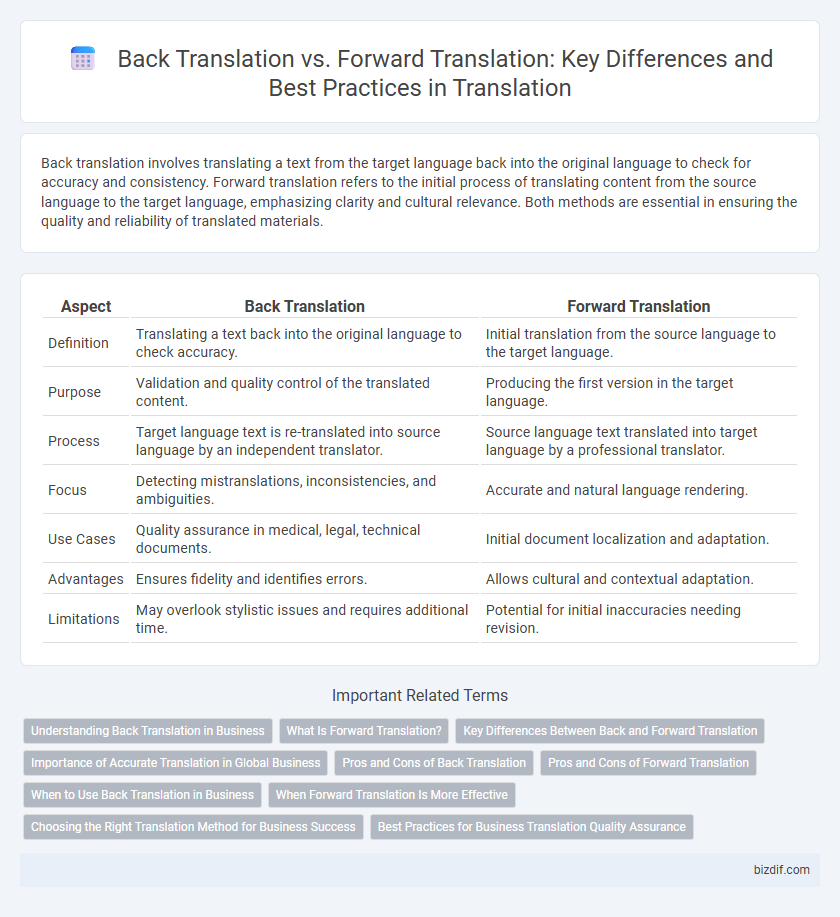Back translation involves translating a text from the target language back into the original language to check for accuracy and consistency. Forward translation refers to the initial process of translating content from the source language to the target language, emphasizing clarity and cultural relevance. Both methods are essential in ensuring the quality and reliability of translated materials.
Table of Comparison
| Aspect | Back Translation | Forward Translation |
|---|---|---|
| Definition | Translating a text back into the original language to check accuracy. | Initial translation from the source language to the target language. |
| Purpose | Validation and quality control of the translated content. | Producing the first version in the target language. |
| Process | Target language text is re-translated into source language by an independent translator. | Source language text translated into target language by a professional translator. |
| Focus | Detecting mistranslations, inconsistencies, and ambiguities. | Accurate and natural language rendering. |
| Use Cases | Quality assurance in medical, legal, technical documents. | Initial document localization and adaptation. |
| Advantages | Ensures fidelity and identifies errors. | Allows cultural and contextual adaptation. |
| Limitations | May overlook stylistic issues and requires additional time. | Potential for initial inaccuracies needing revision. |
Understanding Back Translation in Business
Back translation is a critical quality assurance method in business translation that involves translating a document from the target language back into the source language to verify accuracy and consistency. This process helps identify discrepancies, cultural nuances, and potential misunderstandings that may affect the intended meaning of marketing materials, legal contracts, or product manuals. Businesses rely on back translation to ensure clear communication, maintain brand integrity, and mitigate risks associated with misinterpretation in global markets.
What Is Forward Translation?
Forward translation is the initial process of converting text from the source language into the target language, aiming for accuracy and cultural relevance. This step requires skilled translators to preserve the original meaning while adapting idiomatic expressions and context to fit the target audience. Forward translation is essential in ensuring that the translated content maintains its intended message before undergoing further validation through back translation.
Key Differences Between Back and Forward Translation
Back translation involves translating a target language text back into the source language to check for accuracy and consistency, while forward translation is the initial process of translating content from the source language to the target language. Back translation helps identify discrepancies and potential errors in the forward translation, ensuring semantic equivalence and cultural appropriateness. The key differences lie in their purposes, with forward translation focusing on producing the target text and back translation serving as a quality control mechanism.
Importance of Accurate Translation in Global Business
Back translation and forward translation are critical methods ensuring accuracy and cultural relevance in global business communications. Accurate translation prevents misunderstandings, builds trust with international clients, and maintains brand integrity across diverse markets. Employing both techniques reduces errors, enhances message clarity, and supports effective cross-cultural collaboration.
Pros and Cons of Back Translation
Back translation provides a crucial quality check by revealing discrepancies between the original and translated texts that may be missed in forward translation alone. It can identify subtle errors or cultural misinterpretations, improving overall accuracy in multilingual projects. However, this method is time-consuming and may introduce bias if the back translator inadvertently corrects or alters the meaning rather than assessing it objectively.
Pros and Cons of Forward Translation
Forward translation offers the advantage of preserving contextual meaning by translating source text directly into the target language, which streamlines the workflow and reduces turnaround time. It can capture cultural nuances more effectively when conducted by native speakers, ensuring greater relevance and clarity in the target market. However, forward translation risks introducing initial interpretation errors that may propagate through subsequent steps without the cross-validation present in back translation.
When to Use Back Translation in Business
Back translation is essential in business when verifying the accuracy of critical documents such as contracts, marketing materials, or regulatory submissions to ensure the original meaning is preserved across languages. It helps identify discrepancies, cultural nuances, or potential misinterpretations before launching products or services in new markets. Businesses benefit from back translation during quality control phases to maintain compliance and protect brand integrity in global expansion efforts.
When Forward Translation Is More Effective
Forward translation proves more effective when the source text is clear, culturally neutral, and requires adaptation for the target audience's linguistic nuances, ensuring the translated content resonates naturally. It facilitates an accurate transfer of meaning by leveraging translators who are native speakers of the target language, minimizing ambiguity. This approach is particularly beneficial in marketing, legal, and educational materials where contextual relevance and readability are critical for audience engagement and comprehension.
Choosing the Right Translation Method for Business Success
Choosing between back translation and forward translation significantly impacts business communication accuracy and cultural relevance. Forward translation provides a direct language transfer ideal for initial content adaptation, while back translation serves as a verification tool to ensure semantic consistency and quality control in multilingual projects. Businesses aiming for global market success prioritize forward translation for efficiency and back translation for validation to achieve precise and culturally appropriate messaging.
Best Practices for Business Translation Quality Assurance
Back translation involves translating a text back into the original language to verify accuracy, while forward translation is the initial process of converting content into the target language. Best practices for business translation quality assurance include using both methods in tandem, employing native speakers for forward translation, and leveraging back translation to detect contextual inconsistencies and ensure message integrity. Incorporating iterative reviews and domain-specific glossaries further enhances accuracy and cultural relevance in business communications.
Back Translation vs Forward Translation Infographic

 bizdif.com
bizdif.com